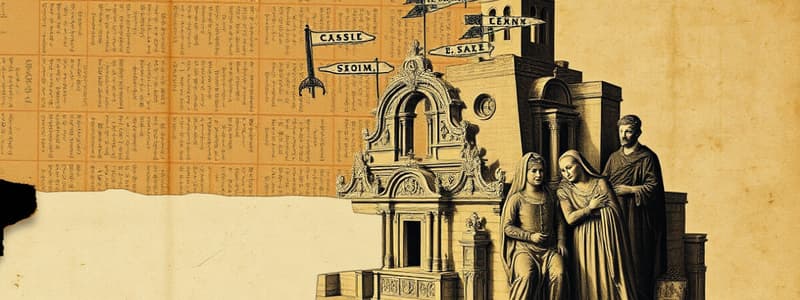Podcast
Questions and Answers
What comprised the social structure during the Renaissance?
What comprised the social structure during the Renaissance?
- Three estates: clergy, nobility, and peasants (correct)
- Two estates: clergy and commoners
- Four estates: clergy, nobility, merchants, and peasants
- Three estates: clergy, nobility, and merchants
By 1500, which group managed to dominate society in the same way as during the Middle Ages?
By 1500, which group managed to dominate society in the same way as during the Middle Ages?
- The clergy
- Merchants and traders
- The nobility (correct)
- Artisans and craftsmen
What was one of the primary expectations of the Renaissance noble based on Castiglione's ideas?
What was one of the primary expectations of the Renaissance noble based on Castiglione's ideas?
- To reject any involvement in public affairs
- To pursue military conquests relentlessly
- To possess a Classical education (correct)
- To engage in scholarly debates exclusively
How did the economic crisis of the fourteenth century affect serfdom in Western Europe?
How did the economic crisis of the fourteenth century affect serfdom in Western Europe?
What is one fundamental endowment a noble should possess according to the ideals by 1500?
What is one fundamental endowment a noble should possess according to the ideals by 1500?
What role did military and bodily exercises play in the life of a Renaissance noble?
What role did military and bodily exercises play in the life of a Renaissance noble?
Which area saw a notable exception to the predominance of peasants as a social class?
Which area saw a notable exception to the predominance of peasants as a social class?
Who authored the influential work 'Book of the Courtier'?
Who authored the influential work 'Book of the Courtier'?
Who were at the top of the urban social hierarchy in cities during the late fourteenth and fifteenth centuries?
Who were at the top of the urban social hierarchy in cities during the late fourteenth and fifteenth centuries?
What significant change occurred due to the Black Death in the second half of the fourteenth century?
What significant change occurred due to the Black Death in the second half of the fourteenth century?
Which group constituted approximately 30 to 40 percent of the urban population during this period?
Which group constituted approximately 30 to 40 percent of the urban population during this period?
What was the primary function of women of the upper and middle classes during this time?
What was the primary function of women of the upper and middle classes during this time?
What was the importance of the dowry in arranged marriages?
What was the importance of the dowry in arranged marriages?
How many slaves were estimated to be shipped from Africa to Portugal between 1444 and 1505?
How many slaves were estimated to be shipped from Africa to Portugal between 1444 and 1505?
What was a major factor contributing to urban poverty in Europe during the late fourteenth and fifteenth centuries?
What was a major factor contributing to urban poverty in Europe during the late fourteenth and fifteenth centuries?
What was a critical aspect of arranged marriage contracts?
What was a critical aspect of arranged marriage contracts?
What was a common consequence of childbirth for upper-class women?
What was a common consequence of childbirth for upper-class women?
What group of individuals did slaves primarily consist of in the Italian market?
What group of individuals did slaves primarily consist of in the Italian market?
Flashcards are hidden until you start studying
Study Notes
Social Structure of the Renaissance
- Inherited from the Middle Ages, structured into three estates: First Estate (clergy), Second Estate (nobility), and Third Estate (peasants and urban inhabitants).
- Nobles, making up 2-3% of the population, dominated society, occupying military and political roles and advising the king.
- By 1500, a reconstruction of the aristocracy was underway, with increasing emphasis on education for maintaining governmental roles.
Castiglione’s Influence
- "The Book of the Courtier," published in 1528 by Baldassare Castiglione, became a key guide for aristocrats across Europe.
- Ideal courtier characteristics: impeccable character, grace, talents, noble birth, military capability, classical education, and a standard of conduct to make a good impression.
Demographics of the Third Estate
- Peasants comprised about 85-90% of the European population, less in urban areas like northern Italy and Flanders.
- Economic shifts led to the decline of serfdom; lords increasingly granted freedom and accepted rents from peasants.
Urban Society Dynamics
- Urban society consisted of patricians (wealthy elite from trade, industry, and banking), shopkeepers and artisans (local goods providers), and lower-class propertyless workers and unemployed, amounting to 30-40% of city populations.
- Urban poverty intensified in the late fourteenth and fifteenth centuries.
Historical Context of Slavery
- Agricultural slavery transitioned to serfdom by the ninth century; slavery reemerged during the Spanish Reconquista.
- After the Black Death, labor shortages led to the revival of slavery in Italy, targeting young females and various ethnic groups, including Tartars and Africans.
- By the late fifteenth century, slavery in Italian cities declined, partly due to humanitarian reasons; Portuguese began importing African slaves significantly from 1444 to 1505.
Marriage and Family Dynamics
- Marriages often arranged to enhance business or social status, with dowry size indicating social mobility.
- Fathers/husbands had absolute authority; wives had no share in wealth and were tasked primarily with childbearing.
- Upper-class women often used wet nurses, while poor women nursed their own children; childbirth had high mortality rates, with 10% of mothers and nearly 50% of merchant children dying before age 20.
- Families sought numerous children to ensure a surviving male heir, reflecting the lack of emotional ties in arranged marriages.
Studying That Suits You
Use AI to generate personalized quizzes and flashcards to suit your learning preferences.




